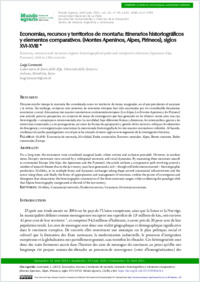Economy, resources and mountain regions : historiographical paths and comparative elements (Apennine Alps, Pyrenees), 16th to 18th centuries : itinerarios historiográficos y elementos comparativos. (Montes Apeninos, Alpes, Pirineos), siglos XVI-XVIII
- Lorenzetti, Luigi Laboratorio di storia delle Alpi (LabiSAlp), Accademia di architettura, Università della Svizzera italiana, Svizzera
- 2021
Published in:
- Mundo agrario. - 2021, vol. 22, no. 49, p. e164
Economías de montaña
Movilidad
Redes comerciales
Recursos naturales
Alpes
Bienes comunes
Europa
Mobility
Commercial networks
Productive sectors
Commons
Mountain economies
English
Spanish
For a long time, the mountains were considered marginal lands, where routine and archaism prevailed. However, in modern times, Europe's mountains were crossed by a widespread economic and social dynamism. By examining three mountain massifs in continental Europe (the Alps, the Apennines and the Pyrenees), the article outlines a comparative path revolving around a number of research themes that in the last twenty years have generated a rich – though still little interconnected – historiographic production. Mobility, in its multiple forms and dynamics, exchanges taking shape around commercial infrastructures and the actors using them, and finally the forms of appropriation and management of resources, outline the points of convergence and divergence that characterize the historiographic orientations of the three mountain ranges, while confirming the paradigm shift that Alpine historiography inaugurated at the end of the last century.
Durante mucho tiempo la montaña fue considerada como un territorio de tierras marginales, en el que prevalecían el arcaísmo y la rutina. Sin embargo, en épocas más recientes, las montañas europeas han sido atravesadas por un considerable dinamismo económico y social. Al examinar tres macizos montañosos continentales europeos (Los Alpes, Los Montes Apeninos y los Pirineos) este artículo pone en perspectiva un conjunto de temas de investigación que han generado en los últimos veinte años una rica historiografía —aunque poco interconectada aún. La movilidad, bajo diferentes formas y dinámicas, los intercambios, gracias a las estructuras comerciales y a sus protagonistas, así como las formas de apropiación y gestión de los recursos, subrayan los elementos de divergencia y convergencia que caracterizan la mencionada historiografía de los tres macizos montañosos referidos. Al hacerlo, confirman el cambio paradigmático con el que se ha iniciado el nuevo siglo en este segmento de la investigación histórica.
- Collections
- Language
-
- French
- Classification
- Medieval and modern history
- License
- Open access status
- gold
- Identifiers
-
- DOI 10.24215/15155994e164
- ARK ark:/12658/srd1325601
- Persistent URL
- https://n2t.net/ark:/12658/srd1325601
Statistics
Document views: 74
File downloads:
- Lorenzetti_2021_mundoagrario: 122
